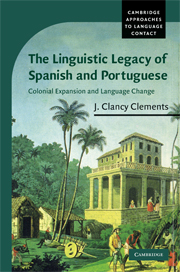Book contents
- Frontmatter
- Contents
- List of figures
- List of maps
- List of tables
- Series editor's foreword
- Acknowledgements
- List of abbreviations and acronyms
- 1 Language contact, language learning, and language change
- 2 The general socio-historical context of Portuguese and Castilian
- 3 Portuguese- and Spanish-lexified creole languages
- 4 Bozal Spanish of Cuba
- 5 Chinese Coolie Spanish in nineteenth-century Cuba
- 6 Chinese Immigrant Spanish
- 7 Andean Spanish
- 8 Barranquenho
- 9 Contact, cognition, and speech community
- Appendix A
- Appendix B
- Bibliography
- Author index
- General index
1 - Language contact, language learning, and language change
Published online by Cambridge University Press: 30 September 2009
- Frontmatter
- Contents
- List of figures
- List of maps
- List of tables
- Series editor's foreword
- Acknowledgements
- List of abbreviations and acronyms
- 1 Language contact, language learning, and language change
- 2 The general socio-historical context of Portuguese and Castilian
- 3 Portuguese- and Spanish-lexified creole languages
- 4 Bozal Spanish of Cuba
- 5 Chinese Coolie Spanish in nineteenth-century Cuba
- 6 Chinese Immigrant Spanish
- 7 Andean Spanish
- 8 Barranquenho
- 9 Contact, cognition, and speech community
- Appendix A
- Appendix B
- Bibliography
- Author index
- General index
Summary
Introduction
Any account of human language must address a host of facts and observations about the structure and use of language varieties of the world, including non-standard varieties such as immigrant speech, pidgins, creoles, and mixed languages. Most linguists, as well as scholars who study different languages from other perspectives (e.g., psychologists, sociologists, etc.), would likely agree with Givón (1998:41) that human language combines two major ‘mega functions’ of representation of knowledge and communication of represented knowledge. As the point of departure for a functional approach to human language, Givón (ibid.:42) proposes the evolutionary-adaptive approach in biology, in which structure (anatomy) and function (physiology) are studied not as separate from, but rather as complements to, one another. Rather than positing a single mutation in human kind that triggers the change from a protolanguage into a full human language (that is, a ‘catastrophic’ event which was the cause for the emergence of basic phrasal–clausal structure (Bickerton 2000:281)), functionalists such as Givón assume a gradual process whereby the link between proto- and full human language is gradual and incremental. Givón frames the distinction not in terms of language, but rather in terms of communication systems, differentiating between pre-grammatical and grammatical communication. He notes that ‘humans can – under a variety of developmental or neurological conditions – communicate readily without grammar, using a well-coded lexicon with some rudimentary combinatorial rules’ (1998:49). The differences between pre-grammatical and grammatical communication are expressed by Givón in terms of the structural, functional, and cognitive properties, shown in Table 1.1, which I have adapted slightly to express the differences as being a matter of degree rather than being dichotomous.
- Type
- Chapter
- Information
- The Linguistic Legacy of Spanish and PortugueseColonial Expansion and Language Change, pp. 1 - 27Publisher: Cambridge University PressPrint publication year: 2009



